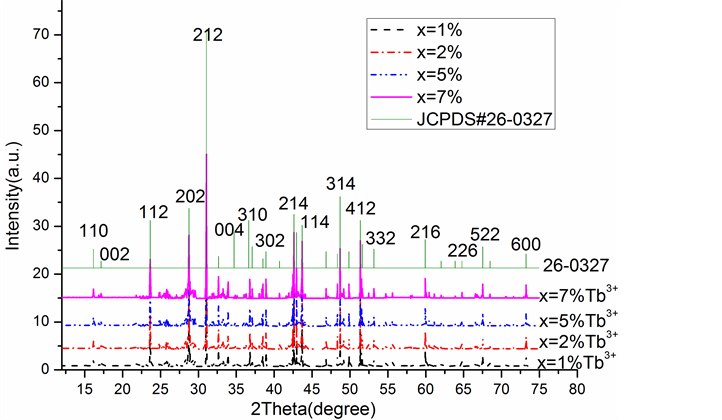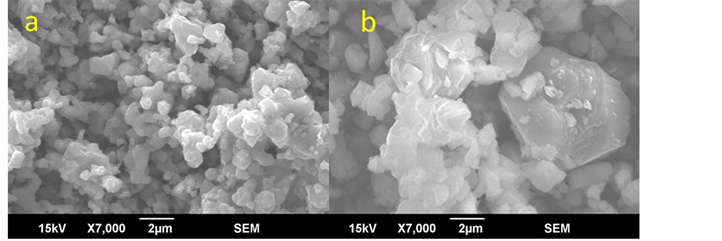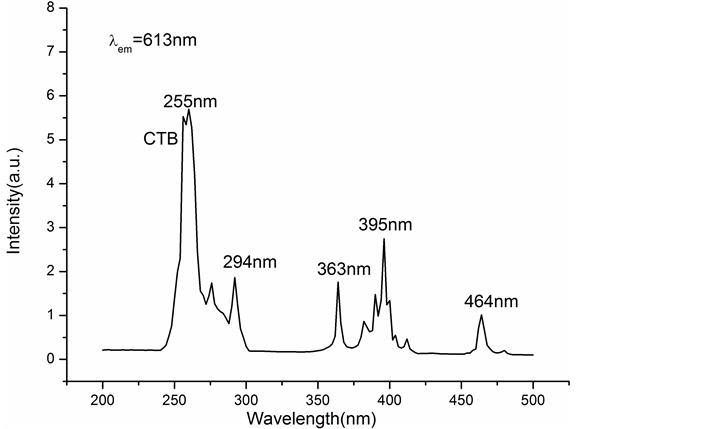1. 引言
白光LED (Light Emitting Diode)因其节能、环保、寿命长等优点,被誉为本世纪最具发展前景的照明技术。目前获得白光的方法主要采用蓝光LED芯片激发YAG:Ce3+黄色荧光粉混合而成,该方案已经被大规模商业应用。但此方法缺少一定红光成分,致使不仅显色指数偏低(Ra~70),而且色温偏高(>7000 K),无法满足暖白光需求(CCT~3000~5000K),使其很难应用于室内照明、印染涂料、医学手术等对显色指数、色温有一定要求的场所 [1] [2] [3] 。因此,研制出性能良好,发光效率高的红色荧光粉,对推动白光LED技术的快速发展起着十分重要的作用。
近紫外光或蓝光照射稀土离子可以获得红色荧光,如商用的红色荧光粉Y2O2S:Eu3+ [4] 、CaS:Eu2+ [5] ,但发光效率低,热稳定性差,光衰大,严重损害了白光LED产品的质量,而且对环境污染较大。稀土离子激活的氮化物基红色荧光粉最近几年获得很大发展,其拥有不俗的红色荧光性能和力热稳定性,如M2Si5N8:Eu2+ (M = Ca, Sr, Ba)、MAlSiN3:Eu2+ (M = Ca, Sr),CaAlSiN3:Eu2+,Sr2−xSi5N8:Eux等 [6] - [10] 。但对于氮基稀土红色荧光粉,由于存在N元素,不仅制备温度较高,还需要保护性气氛,制备成本很高,限制了大规模的实际应用 [11] 。
硅酸盐为基质的荧光粉不仅具有良好的化学、热稳定性,还有良好的环保性,因此被广泛用于荧光粉基质材料 [12] 。CaSrAl2SiO7是一种优异的硅铝酸材料,不仅具有硅酸盐的特性,而且含有部分铝酸盐的力学性能,CaSrAl2SiO7:Eu3+荧光材料已经被H.Y.Jiao等报道 [13] ,研究表明该材料拥有较好的红光发射性能。为了增强Eu3+红光发射强度,通常引入Tb3+为敏化离子,在Tb3+与Eu3+共掺杂时,由于存在能量传递,可显著提高Eu3+发射强度的效果 [14] [15] 。本文采用溶胶–凝胶–高温固相合成法制备了3% Eu3+/x% Tb3+:CaSrAl2SiO7(x = 1, 2, 5, 7)系列纳米粉体,并对其进行了结构和光谱研究,该工作迄今为止并未见报道。
2. 实验部分
2.1. 3%Eu3+/x%Tb3+:CaSrAl2SiO7(x = 1, 2, 5, 7)粉体的制备
实验中选用高纯度试剂Eu2O3 (99.99%,赣州稀土有限公司),Tb(NO3)3,CaCO3 (99.95%, 1 μm),SrCO3 (99.99%, 1 μm),Al2O3 (99.99%, 50~100 nm),SiO2 (99.99%, 50~100 nm)。按照适量配比称取Eu2O3,Tb(NO3)3,CaCO3,SrCO3,Al2O3溶于稀硝酸中,按照n金属离子:nEDTA = 1:1.1称取EDTA,并将其溶解到氨水溶液中形成EDTA氨水溶液,然后在80℃下磁力搅拌反应6 h,得到湿凝胶。将湿凝胶在160度下烘干4 h,即可得到干凝胶,将干凝胶在600度下煅烧2 h得到前驱体,然后再混合适当比例的SiO2原料,并在1000℃~1150℃下煅烧2 h,退火后可得到3% Eu3+/x% Tb3+:CaSrAl2SiO7(x = 1, 2, 5, 7)粉体材料。
2.2. 样品表征
采用Rigaku Miniflex600 XRD (Cu-Kα, λ = 0.1540 nm)衍射分析仪器测定了样品的结构,并用日立公司的Field Emission Scanning Electron Microscope (FESEM)对样品的微纳结构进行了测试,利用Edinburgh Instruments的FLS980荧光光谱仪系统对样品激发和发射谱进行了测试。
3. 结果与讨论
3.1. 物相分析
根据标准卡片(JCPDS#26-0327),CaSrAl2SiO7空间群为P212121,a = b = 0.7751 nm,c = 10.320 nm,结构与Sr2Al2SiO7类似。图1显示了本实验中3% Eu3+/x% Tb3+:CaSrAl2SiO7(x = 1, 2, 5, 7)系列样品的X-射线衍射谱与标准卡片(JCPDS#26-0327)的对比关系。从图中可以看出,Tb3+掺杂浓度的增加对晶格的结构影响很小,主要原因在于掺杂浓度较低,并未造成严重的晶格畸变。与纯CaSrAl2SiO7标准粉末衍射卡片比较,本实验系列样品的主要衍射峰位置与其一一对应,其中(212)位置具有最大衍射强度,这说明样品在微量稀土掺杂情况下,与纯CaSrAl2SiO7结构一致,整批次样品均为纯相。
图2为3% Eu3+/2% Tb3+:CaSrAl2SiO7样品在温度为1000℃和1150℃时的SEM图。图中左边(a)为1000℃时的SEM图,颗粒直径约为300~400 nm,右边(b)为1150℃时的SEM图,颗粒直径约为600~700 nm,部分颗粒团聚成片状结构。结果表明随着烧结温度的增加,颗粒尺寸也显著增加,并且团聚现象也更加明显,但总的说来,在1000℃~1150℃温区范围内,样品基本呈现300~700 nm粒径的微纳结构特征。

Figure 1. Comparison of X-ray diffraction patterns between 3% Eu3+/x% Tb3+:CaSrAl2SiO7(x=1,2,5,7) samples and standard pattern of JCPDS#26-0327
图1. 3% Eu3+/x% Tb3+:CaSrAl2SiO7(x = 1,2,5,7)粉体的X射线衍射谱与标准卡片(JCPDS#26-0327)的对比关系
3.2. 激发与发射光谱分析
图3为3% Eu3+/Tb3+:CaSrAl2SiO7的激发光谱,监测波长为613 nm。从图中可以看出,最强的激发峰位于255 nm的宽激发带,该宽激发带主要由于Eu3+→O2-的电荷转移,大量文献已经对其机理有着较为详细的讨论。其次,395 nm也存在较强的激发峰,该激发带对应于Eu3+离子的特征峰7F0→5L6。因此,可以利用255 nm和395 nm入射3% Eu3+/Tb3+:CaSrAl2SiO7材料并分析其613 nm红光发射情况。
图4为3% Eu3+/7% Tb3+:CaSrAl2SiO7的激发光谱,监测波长为545 nm。从图中可以看出,最强激发峰位于248 nm的激发带,属于Tb3+离子的f-d跃迁。在300~400 nm之间还有一个激发带,对应于f-f跃迁。
图5显示了3% Eu3+/x% Tb3+:CaSrAl2SiO7(x = 1, 2, 5, 7)样品在255 nm波长激发下的发射谱。从图中可以看出,主要发射峰位于545 nm,585~592 nm和613 nm。其中,中心波长为590 nm的黄光和613 nm

Figure 2. SEM micrographs of 3% Eu3+/2% Tb3+:CaSrAl2SiO7 sample calcined at (a) 1000˚C and (b) 1150˚C
图2. 3%Eu3+/2%Tb3+:CaSrAl2SiO7 SEM图;(a)和(b)分别为1050℃和1150℃合成条件

Figure 3. Excitation spectra of 613 nm emission in 3% Eu3+/7% Tb3+:CaSrAl2SiO7 samples
图3. 3% Eu3+/7% Tb3+:CaSrAl2SiO7在613 nm波长发射时的激发谱

Figure 4. Excitation spectra of 545 nm emission in 3% Eu3+/7% Tb3+:CaSrAl2SiO7 sample
图4. 3% Eu3+/7% Tb3+:CaSrAl2SiO7在545 nm波长发射时的激发谱

Figure 5. Emission spectra of 3% Eu3+/x% Tb3+:CaSrAl2SiO7 (x=1,2,5,7) samples excited with 255nm.
图5. 3% Eu3+/x%Tb3+:CaSrAl2SiO7 (x=1,2,5,7)样品在255 nm 激发下的发射谱
的红光分别对应Eu3+离子的5D0→7F1, 5D0→7F2跃迁;而545 nm,586 nm发射峰,分别对应Tb3+的5D4→7F5, 5D4→7F4跃迁。随着Tb3+浓度的增加,发射光谱略有不同,主要体现在以下方面:第一是545 nm的蓝光发射带,随着Tb3+浓度增加,其发射变得越来越明显;第二是585~592 nm波段,随着Tb3+浓度增加分叉峰也越来越明显,同时黄光发射波段的FWHM变得越来越宽;第三是613 nm的红光发射峰,随着Tb3+浓度增加也逐渐增强。
对3%Eu3+/x%Tb3+:CaSrAl2SiO7样品进行了量子效率测试 [16]
 (1)
(1)
其中, 和
和 为激发谱和发射谱中光强度。最后得到613 nm处的离子效率分别为46±1%,48±1%,53±1%,55±1% (x = 1%, 2%, 5%,7%)。因此,随着Tb3+掺杂浓度的增加,Eu3+离子的黄光和红光发射也跟着增强,这表明在255 nm波长照射下,Tb3+的部分能量向Eu3+离子转移,从而使得固定Eu3+离子浓度也能获得更高的发光效率。同时,Tb3+的另外一部分能量继续为545 nm绿光提供跃迁能量,从而使得整个3%Eu3+/x%Tb3+:CaSrAl2SiO7(x = 1, 2, 5, 7)样品存在绿光–黄光–红光三色光强度分布,这使得其在白光LED领域具有潜在的应用前景。
为激发谱和发射谱中光强度。最后得到613 nm处的离子效率分别为46±1%,48±1%,53±1%,55±1% (x = 1%, 2%, 5%,7%)。因此,随着Tb3+掺杂浓度的增加,Eu3+离子的黄光和红光发射也跟着增强,这表明在255 nm波长照射下,Tb3+的部分能量向Eu3+离子转移,从而使得固定Eu3+离子浓度也能获得更高的发光效率。同时,Tb3+的另外一部分能量继续为545 nm绿光提供跃迁能量,从而使得整个3%Eu3+/x%Tb3+:CaSrAl2SiO7(x = 1, 2, 5, 7)样品存在绿光–黄光–红光三色光强度分布,这使得其在白光LED领域具有潜在的应用前景。
4. 结论
采用溶胶–凝胶–高温固相合成法制备了3%Eu3+/x%Tb3+:CaSrAl2SiO7(x = 1, 2, 5, 7)纳米粉体,并对其微纳结构和光谱性能进行了表征。在温度为1000℃~1150℃合成条件下,测得颗粒尺寸约为300~700 nm。利用255 nm紫外光照射样品,观察到545 nm,585~592 nm和613 nm三个典型的发射带,分别对应Eu3+离子的(590 nm)5D0→7F1, (613 nm) 5D0→7F2跃迁和Tb3+的(545 nm) 5D4→7F5, (586 nm) 5D4→7F4跃迁。随着Tb3+浓度增加,三个发射带强度均有明显增强,这表明Tb3+能量其中一部分转移给Eu3+离子,而另外一部分激发Tb3+离子的545 nm绿光。实验结果表明3%Eu3+/x%Tb3+:CaSrAl2SiO7(x = 1, 2, 5, 7)纳米粉体可以同时产生红黄绿三种色光,使其在白光LED领域具有潜在的应用价值。
基金项目
福建省科技厅项目(2016J01752)和教育厅项目(JA15537, JK2015057)。